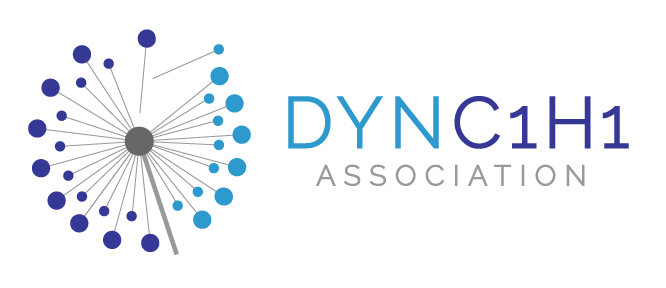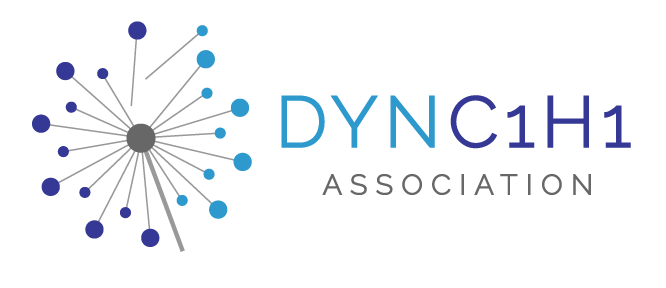6 Things to do after a DYNC1H1-Related diagnosis
Receiving a DYNC1H1-related disorder (DRD) diagnosis can be incredibly overwhelming. We’re here to help. These six steps can help you prepare for the future without overwhelming you in the present. Each step has been carefully curated from the accumulated of years of experience from community members in conjunction with DYNC1H1-related disorder medical experts, educational experts, and best practices in the rare disease community. The goal is to help you build a strong foundation for medical care and community support.




1. Get a Copy of the Genetic Report
Your genetic report contains critical technical information that future medical providers will need. Request a complete copy that includes:
The exact location and type of your genetic variant (the p. and c. values, as well as a string of values that start with NM_…)
The laboratory's classification of the variant’s likelihood to be causing the disorder symptoms, which will be one of these:
Pathogenic (P): Strong evidence this genetic change causes disease
Likely Pathogenic (LP): Good evidence this genetic change causes disease
Variant of Uncertain Significance (VUS): Not enough evidence yet to be sure if this change causes disease
Documentation of who ordered the testing and which laboratory completed it.
This is important because we may have to petition the laboratory for a change in classification in order for participation in some research studies.
This information will be essential for accessing specialized care, participating in research, and understanding your specific genetic change.
2. Complete Seizure First Aid Training
Since 40-60% of individuals with DYNC1H1 gene variants experience seizures. These can develop anytime from infancy to adulthood. Being prepared is crucial. Seizures can have many different physical symptoms. Take these important steps:
Learn to recognize different types of seizures and their warning signs.
Complete formal seizure first aid training through your local epilepsy foundation or hospital, and encourage caretakers of your children to do the same.
If you are worried you or your child are having seizures, visit a neurologist who specializes in epilepsy. Bring videos of any suspected seizure behavior.
Training is offered for free through the Epilepsy Foundation, and they also offer Seizure First Aid posters & resources in a wide variety of languages.
3. Register with the DYNC1H1 Association's Patient Contact Registry
The registry is a vital connection point for the DYNC1H1 community. Registration allows you to:
Connect with other affected individuals and families, including anyone nearby or those with identical variants.
Participate in cutting-edge research efforts - occasional surveys, research study recruitment from our partners.
Help guide the development of treatments and potential cures by sharing your story with us and allowing us to know what’s important to you.
Access exclusive in-person and virtual educational events: talks with researchers, community chats, and webinars featuring DYNC1H1 experts and researchers
4. Request Key Provider Appointments
There are some specialists that have more experience with complex, rare disorders like DYNC1H1-Related Disorders. Most of the time, these specialties are uncommon enough that a typically developing person will not have even heard of them. Due to long wait times, it’s a good idea to request these specialist appointments as soon as symptoms present or are suspected:
Developmental-Behavioral Pediatricians
Evaluate developmental progress, with a focus on patients who have developmental disorders, either physical, cognitive, behavioral, or all three.
Recommend appropriate interventions & help provide support to access these interventions. They may suggest more specialized physical, occupational, and behavioral therapies and have networks that can provide these services to more complex individuals.
Monitor behavioral challenges over time and make referrals for evaluations and supplemental care.
Physiatrists (Physical Medicine and Rehabilitation Doctors)
Assess mobility and function slightly different from a physical therapist or orthotist. Often these practitioners are almost like a combination of a physical therapist and orthopedist. They look at muscle, nerve, and skeletal development in combination to come up with a full picture of the individual’s mobility and motor skills.
Coordinate physical therapy and suggest plans of care, may complete certain baseline testing to have data in case of progression. As a parent, we suggest asking the doctor about motor function tests (standardized assessments of mobility) after the child has reached age 8 or above.
Recommend assistive devices like orthotics, crutches, wheelchairs, walkers, standing frames, or similar equipment that may help support the patient’s mobility while still allowing them to gain strength.
Neuro-ophthalmologists or Vision Therapy Specialists
Evaluate eye movement, visual tracking, and other physical requirements for functional vision.
Assess nerve function related to vision by looking at the back of the eye. This is to observe the health of the retina, the part of the eye where light is absorbed and nerves transport that information to the brain.
Look for complications like cortical visual impairment, a condition where the eye is healthy, but information is processed improperly by the brain. This is particularly common in patients with brain malformations. For more information, see (Perkins School for the Blind). Look out for announcements about Spring 2025 talks about accommodating for CVI and other visual impairments!
Individual and Family Therapists.
Help families adjust to disability-related challenges and the often challenging family dynamics that go along with them. Therapists will often offer both group and individual sessions. Making sure to interview therapists to find one or more that work for your family, there are many different techniques and strategies that can be utilized depending on what you are seeking help with.
Provide coping strategies and skills for managing stress, difficult emotions, parent training for behavioral management
Support family emotional well-being and help acknowledge and process emotions
Assist with stress management
There are some directories of therapists that are familiar with disability parenting:
Within the USA: Amanda Griffith Atkins Therapist Directory
Within the UK: Affinity Hub
Additional Resources:
Twice a month, free support group for parents of disabled or medically complex children
Peer support groups for rare disease caregivers through Give an Hour.
Additional support groups and mental health resources for rare disease caregivers through Angel Aid.
5. Take Baseline Videos
Over 30% of patients experience symptom progression during or near adulthood. This progression can sometimes be sudden and dramatic, so documenting your or your loved one’s baseline function is crucial. Recording well lit, well focused videos of the patient doing certain tasks can help ensure that any and all changes are clear to medical professionals. Videos of walking, going up stairs, hopping, sitting up, crawling, or similar will assist with figuring out if these skills are changing for better or for worse. Videos of eating and conversation could help diagnose changes in speech-related skills. Recording of writing, puzzles, threading, and other fine motor tasks can serve the same purpose.
In short, having videos of your loved ones can:
Provide clear evidence of changes if urgent medical care is needed.
Help convince doctors and insurance companies of the need for immediate evaluation if symptoms worsen, or argue for continuation of services if symptoms are improving.
Create valuable documentation for medical research studies to help determine eligibility.
Allow medical teams and family members to objectively see how symptoms looked before any decline.
Record:
Walking patterns and general movement.
Fine motor skills and hand usage.
Speech patterns and clarity.
Daily living activities, like eating or feeding, transferring from seat to seat or standing, climbing stairs and playing.
Store these recordings securely, date them, and back them up in multiple places for future reference.
6. Learn About Common Behavioral and Developmental Disorders
More than half of individuals with DYNC1H1-related disorders experience Behavioral, Developmental, or Cognitive challenges. Understanding what they are and what to look for can help secure early intervention services, help you reframe your parenting to better work with your child, and reduce the stress of long waiting lists while waiting for definitive answers.
Intellectual Disability
May affect learning speed and comprehension
Can impact daily living skills
Varies widely in severity from mild to severe
Screening tests include: Wechsler Preschool and Primary Scale of Intelligence (WPPSI) (ages 2-5), Wechsler Intelligence Scale for Children (WISC) (ages 6-16), Stanford-Binet Intelligence Scale (2-adulthood), and the Adaptive Behavior Assessment System (ABAS).
Attention Deficit Disorder (ADHD)
Difficulty staying focused or following instructions
May struggle with organization and completing tasks
Can show hyperactive or impulsive behaviors
Screening usually starts at age 4, with common assessments including: Vanderbilt Assessment Scales, Conners Rating Scales, ADHD Rating Scale-6, and computerized Continuous Performance Tests.
Autism Spectrum Disorder
Differences in social communication and interaction
May have specific routines or repetitive behaviors
Can include sensory sensitivities
Screening can happen as early as 12 months using the Modified Checklist for Autism in Toddlers (M-CHAT), Autism Diagnostic Observation Schedule (ADOS-2), Childhood Autism Rating Scale, 2nd Edition (CARS2), The Autism Diagnostic Interview-Revised (ADI-R) for parents of children ages 2 and up, with the Social Communication Questionnaire for ages 4 and up.
Obsessive Compulsive Disorder (OCD)
Recurring unwanted thoughts, urges, or images that cause marked anxiety or distress
Repetitive behaviors (such as hand washing) or mental acts (such as counting, repeating words silently) that a person feels driven to perform due to obsessive thoughts
Screening begins around age 5, though symptoms may develop earlier. Common tools include the Yale-Brown Obsessive Compulsive Scale (CY-BOCS), the Child Behavior Checklist, and the Leyton Obsessional Inventory.
Understanding these conditions helps in several ways:
Guides you to effective parenting strategies specific to each challenge
Helps you advocate for appropriate school accommodations
Allows you to identify signs early and seek proper support
Schedule a neuropsychological evaluation early, as wait times typically range from 6-12 months. Testing often combines multiple tools for accuracy, as each provides different insights into a child's development and challenges. Some scales ask for input from school or family, so be sure to get those well in advance of the evaluation day.
Physical disabilities can significantly affect test performance, so experienced evaluators may need to modify standard procedures. Make sure to ask to discuss this with an evaluator prior to arriving at the appointment. Some tools may need adaptation for children with mobility or speech challenges related to their DYNC1H1 diagnosis, and not every evaluator is capable of doing so. Results should always be interpreted considering the whole child, including their medical history, development, family observations, school performance, and environmental factors.
Remember: These screenings should be conducted by qualified professionals who understand both the testing tools and the complexities of DYNC1H1-related disorders. Early screening leads to earlier intervention, which often results in better outcomes.
A Note to Healthcare Providers
As a healthcare provider, your role is crucial in supporting patients with DYNC1H1-related disorders. These patients are often left adrift with few real answers, an absolutely need your support. Please help them to:
Order copies of the genetic report for your records, even if you did not order the test.
Make appropriate specialist referrals promptly, recognizing the significant wait times and often urgent nature of the symptoms, like aggressive behavior and self-harm.
Document baseline functioning through your own clinical observations, making sure all concerns are clearly recorded in the patient’s medical record.
Support requests for early neuropsychological evaluations.
Provide seizure education and safety planning or taking seriously parent concerns regarding the likelihood of epilepsy development in this condition.
Connect families with the DYNC1H1 Association's resources, including our Information Sheet.
Consider writing a letter of medical necessity for any evaluations or services that may face insurance barriers, and encourage the patient to call if they receive denial of service.
Your early intervention and thorough documentation can significantly impact both immediate care and long-term outcomes for individuals with DYNC1H1-related disorders. The steps outlined in this guide represent essential foundations for comprehensive care - please partner with families to ensure these steps are completed as early as possible after diagnosis.

